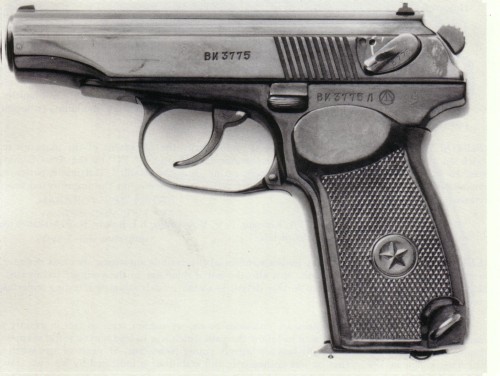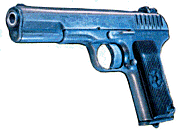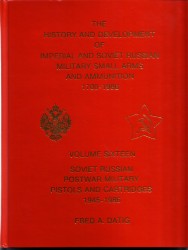CRUFFLER.COM
presents
HISTORIC
FIREARM OF THE MONTH,
February
2000:
 |
 |
 |

Image Credit: Datig, Fred A., Soviet Russian Postwar Military Pistols and Cartridges, 1945 - 1986, Handgun Press (Glenview, Illinois, 1988) Page 30 |
Type:
Double Action Self Loading Pistol
System of Operation: Blowback Caliber: 9x18mm (9mm Makarov) Capacity: 8+1 rounds Sights: Blade front, fixed u-notch rear Length: 6.34" Weight (loaded): 1.71 pounds Barrel: 3.83", 4 groove, right-hand twist |
Tula-Tokarev
"TT" Pistol

Image Credit: The Original Tokarev Site http://www.cvn.net/roo67/ |
As a result of the military use of pistols during the Great Patriotic War, a competition was announced in 1945 for the development of a new service pistol to replace the TT. The new pistol was to be of |
Competitors included Tokarev, Simonov, Korovin, Voyevodin, Rakov, and Makarov. From what is known about the competition, the characteristics that were sought boiled down to:
1. The best possible ballistic characteristicsOne answer to these requirements was that the gun was to be a straight blowback design. This would be less complicated and easier/cheaper to manufacture. Additionally, this would go a long way toward meeting the dimensional and weight requirements. According to Dr. D.N. Bolotin, in his doctoral thesis "Fifty Years of Soviet Small Arms, 1917-1967:"
2. Maximum simplification of production procedures
3. Minimization of per unit production costs without sacrificing quality
Certainly the most important and interesting feature of the Makarov "PM" pistol is its mechanism-to-caliber/catridge relationship. In simple terms, this means the theory of producing the most powerful results with the simplest type of breech action, this being the simple blowback or unlocked breech. . . .Walther was working on the basic principle of designing the ultimate ("Ultra") unlocked breech, blowback system pistol to the highest degree of efficiency.Indeed, the heart of the Makarov pistol is the 9mm Makarov cartridge. This cartridge, and its development warrant some discussion as it is as critical to the Makarov's development and success as the pistol's physical characteristics.
The Makarov cartridge has lineal roots in the 9mm and 8mm Ultra projects undertaken by Walther in World War Two Germany. The Soviets found themselves with unfettered access to many German weapons development projects (a la bayonet!) at the close of the war, and the "Ultra" pistol cartridge projects were no exception.
There are three basic types of pistol cartridge case geometries: Straight sided, like the .45 ACP, tapered, like the 9x19mm, and bottlenecked, like the 7.65mm Parabellum. Tapered cases are better suited to locked breech mechanisms than straight sided cases. This is due to the fact that as soon as the fired case begins to move rearward it is freeing itself from the chamber walls, permitting gas to escape to the rear, and impinge upon the breech face to assist in the unlocking process.
Conversely, straight sided cases are better suited for blowback pistols as there is no escape of gas to the rear until the fired case is completely free from the chamber. Additionally, the walls of the case are constantly in contact with the walls of the chamber as the case moves to the rear, this contact increasing the friction between case and chamber considerably, and acting, with the recoil spring, as a delaying mechanism. By using a straight sided case, much less force is placed on the breech face. It is for this reason that a straight sided case had to be chosen for the Makarov.
Now, the goal of the 9mm Ultra project was to retain the use of the 9mm Parabellum projectile in a straight sided case. In order to achieve a straight sided case and still use the same bullet, the German engineers opted to alter the case to fit the bullet. The result was a decrease in the diameter of the 9mm Parabellum's 10mm base to between 9.45mm and 9.50mm. The result was a 9mm Parabellum round that had been straightened from its conical form by reducing the diameter of the lower portion of the case some .50mm from the original 10mm diameter.
While developing the 9mm Makarov cartridge, the Soviet engineers took the opposite track. Instead of retaining the 9mm Parabellum bullet, they kept the 10mm base diameter and expanded the case mouth dimensions to produce a straight walled case. As a result, the new round needed a bullet of between 9.25mm and 9.30mm in diameter as opposed to 9mm. To allow Makarov to use a shorter, more compact mechanism, the 9mm Ultra's 19mm case was shortened to 18mm. The use of a stubby, flat based bullet ensured that there would be more than adequate powder space in the case. Additionally, the 9mm Makarov case uses the "thick wall" principle wherein the thickness of the case walls does not decrease as it approaches the case mouth. This both provided a safeguard against split case necks and allowed for higher pressures which in turn made for higher velocities.
The result of the Soviets' efforts was that the 9mm Makarov round, when fired from the PM's 3.83" barrel gives a muzzle velocity of 1,050 feet per second, which compares well with the 885 foot per second velocity of the 9mm Short (.380 ACP) and the 1,250 foot per second velocity of the 9mm Parabellum military loading.
After several years of development of both pistols and cartridges, the 9mm Makarov pistol was adopted by the Soviet Army in 1951.
The pistol finally developed, the "PM" is a blowback operated self loading semiautomatic pistol. It has a fixed, non-moving barrel, and a double action trigger mechanism with an external hammer. The pistol can also be fired in a single action mode.
It is often asserted that the PM is a copy of the Walther PP, but this is not entirely correct. While they are both blowback operated, double action pistols with a fixed barrel and external hammer, and similar disassembly procedure, there are significant differences. In addition to the cartridge differences, the mainsprings are significantly different. In the PP, it is a coiled spring which serves only as the mainspring. In the PM, the mainspring has three additional functions: It is the disconnector spring, the magazine retaining spring, and the magazine release spring and catch. Additionally, the PM has an external slide stop lever, a significantly different disconnectors, sear-trigger linkages, and manual safeties (the PM's safety locks the slide and prevents cocking the hammer). Additionally, the PM's bore is chrome lined.
The PM has served the Soviet Union, and now the Russian federation well for the past forty-nine years. Additionally, the former East Germany, Bulgaria and the People's Republic of China produced the PM indigenously for issue to their forces, and Poland, Czechoslovakia, and Hungary designed 9mm Makarov caliber firearms for their forces.
Many
of these guns, notably the Bulgarian and East German PM's and the Hungarian
PA63 and R61 are available on the US market at very reasonable prices,
with abundant, readily available, inexpensive ammunition. For the
Cold War historian or the shooter who wants an inexpensive, well made,
accurate, and reliable piece, it is hard to go wrong with the PM or any
of the 9mm Makarov service pistols.
BIBLIOGRAPHY
Datig, Fred A., Soviet Russian Military Pistols and Cartridges 1946-1986, (Handgun Press, Glenview, Illinois: 1988)
Soviet
Russian Military Pistols and Cartridges 1946-1986 is available from
Amazon.com. Click on the image to order:

|
|